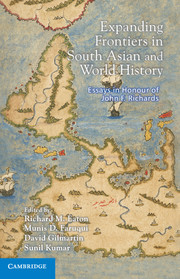Book contents
- Frontmatter
- Contents
- List of Contributors
- Foreword
- Introduction
- 1 At Empire's End: The Nizam, Hyderabad and Eighteenth-century India
- 2 The Ignored Elites: Turks, Mongols and a Persian Secretarial Class in the Early Delhi Sultanate
- 3 ‘Silk Road, Cotton Road or … Indo-Chinese Trade in Pre-European Times’
- 4 The Political Economy of Opium Smuggling in Early Nineteenth Century India: Leakage or Resistance?
- 5 Opium and the Company: Maritime Trade and Imperial Finances on Java, 1684–1796
- 6 The Mughals, the Sufi Shaikhs and the Formation of the Akbari Dispensation
- 7 Notes on Political Thought in Medieval and Early Modern South India
- 8 Becoming Turk the Rajput Way: Conversion and Identity in an Indian Warrior Narrative
- 9 Nature and Nurture on Imperial China's Frontiers
- 10 The Frontiers of Memory: What the Marathas Remembered of Vijayanagara
- 11 ‘Kiss My Foot,’ Said the King: Firearms, Diplomacy and the Battle for Raichur, 1520
- 12 Frontiers of Family Life: Early Modern Atlantic and Indian Ocean Worlds
- 13 Chinese Revenue Farms and Borders in Southeast Asia
- Publications
- Index
11 - ‘Kiss My Foot,’ Said the King: Firearms, Diplomacy and the Battle for Raichur, 1520
Published online by Cambridge University Press: 05 January 2014
- Frontmatter
- Contents
- List of Contributors
- Foreword
- Introduction
- 1 At Empire's End: The Nizam, Hyderabad and Eighteenth-century India
- 2 The Ignored Elites: Turks, Mongols and a Persian Secretarial Class in the Early Delhi Sultanate
- 3 ‘Silk Road, Cotton Road or … Indo-Chinese Trade in Pre-European Times’
- 4 The Political Economy of Opium Smuggling in Early Nineteenth Century India: Leakage or Resistance?
- 5 Opium and the Company: Maritime Trade and Imperial Finances on Java, 1684–1796
- 6 The Mughals, the Sufi Shaikhs and the Formation of the Akbari Dispensation
- 7 Notes on Political Thought in Medieval and Early Modern South India
- 8 Becoming Turk the Rajput Way: Conversion and Identity in an Indian Warrior Narrative
- 9 Nature and Nurture on Imperial China's Frontiers
- 10 The Frontiers of Memory: What the Marathas Remembered of Vijayanagara
- 11 ‘Kiss My Foot,’ Said the King: Firearms, Diplomacy and the Battle for Raichur, 1520
- 12 Frontiers of Family Life: Early Modern Atlantic and Indian Ocean Worlds
- 13 Chinese Revenue Farms and Borders in Southeast Asia
- Publications
- Index
Summary
INTRODUCTION
Frontiers may be understood as spatial counterparts to revolutions: the one denotes a perceived break in continuous territory, the other a perceived rupture in time. In recent decades, historians have written of a worldwide military, or ‘gunpowder’ revolution that took place in the centuries following the fourteenth. Such a notion has in turn prompted several lines of enquiry. Some have tried to locate the moment in time when this revolution occurred in particular regions. Others have sought to identify and compare the various effects that the advent, spread and use of gunpowder had in different socio-political environments across the planet.
The present essay explores a little-studied event in South Asian history, the Battle for Raichur (1520), with a view to evaluating that battle's relevance both to the idea of the frontier and to that of the military revolution. The city of Raichur occupies the heart of an exceptionally fertile tract in India's Deccan plateau—the so-called ‘Raichur Doab’—which lies between the Tungabhadra and Krishna rivers (see Figure 1, Map). For several centuries before 1520, the Bahmani sultans to the north of the Doab and the kings of Vijayanagara to the south repeatedly fought over access to the Doab's economic resources. Control of the fortified city of Raichur figured in all of these struggles. The battle in question was also a prelude to the more famous Battle of Talikota (1565), a conflict that permanently reconfigured the geopolitics of the Deccan plateau.
- Type
- Chapter
- Information
- Expanding Frontiers in South Asian and World HistoryEssays in Honour of John F. Richards, pp. 275 - 298Publisher: Cambridge University PressPrint publication year: 2013

